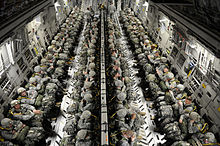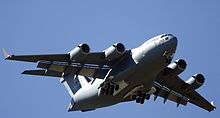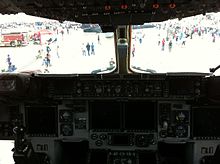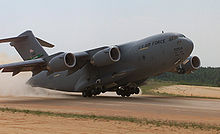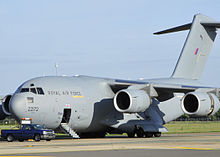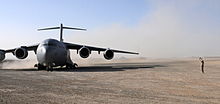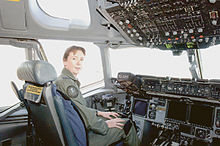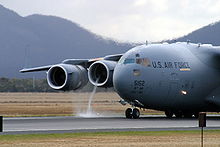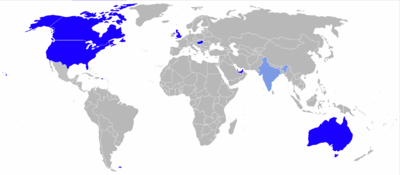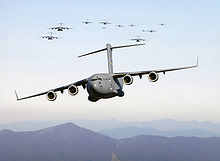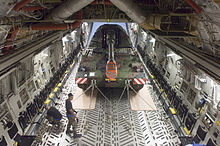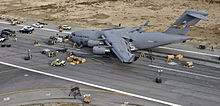- Boeing C-17 Globemaster III
-
For other aircraft with this designation, see C-17 (disambiguation).
C-17 Globemaster III The first C-17 flying a test sortie in 2007. Role Strategic/tactical airlifter National origin United States Manufacturer McDonnell Douglas / Boeing First flight 15 September 1991 Introduction 14 July 1993 Status In production, and in service Primary users United States Air Force
Royal Air Force
Royal Australian Air Force
Royal Canadian Air ForceNumber built 232 as of June 2011 Unit cost US$191 million (2010)[1] Developed from McDonnell Douglas YC-15 The Boeing (formerly McDonnell Douglas) C-17 Globemaster III is a large military transport aircraft. Developed for the United States Air Force (USAF) from the 1980s to the early 1990s by McDonnell Douglas, the C-17 is used for rapid strategic airlift of troops and cargo to main operating bases or forward operating bases throughout the world. It can also perform tactical airlift, medical evacuation and airdrop missions. The C-17 carries the name of two previous, but unrelated piston-engine, U.S. military cargo aircraft, the Douglas C-74 Globemaster and the Douglas C-124 Globemaster II.
In addition to the U.S. Air Force, the C-17 is operated by the United Kingdom, Australia, Canada, Qatar, United Arab Emirates and NATO Heavy Airlift Wing. Additionally, India has approved the purchase of C-17s.
Contents
Development
Background and design phase
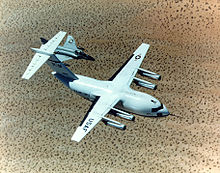 The McDonnell Douglas YC-15 design was used as the basis for the C-17.
The McDonnell Douglas YC-15 design was used as the basis for the C-17.
In the 1970s, the U.S. Air Force began looking for a replacement for its C-130 Hercules tactical cargo aircraft.[2] The Advanced Medium STOL Transport (AMST) competition was held, with Boeing proposing the YC-14, and McDonnell Douglas proposing the YC-15.[3] Though both entrants exceeded specified requirements, the AMST competition was canceled before a winner was selected. The Air Force started the C-X program in November 1979 to develop a larger AMST with longer range to augment its strategic airlift.[4]
By 1980, the USAF found itself with a large fleet of aging C-141 Starlifter cargo aircraft. Compounding matters, USAF needed increased strategic airlift capabilities to fulfill its rapid-deployment airlift requirements. The USAF set mission requirements and released a request for proposals (RFP) for C-X in October 1980. McDonnell Douglas elected to develop a new aircraft based on the YC-15; Boeing bid an enlarged three-engine version of its AMST YC-14. Lockheed submitted two designs, a C-5-based design and an enlarged C-141 design. On 28 August 1981, McDonnell Douglas was chosen to build its proposed aircraft, then designated C-17. Compared to the YC-15, the new aircraft differed in having swept wings, increased size, and more powerful engines.[5] This would allow it to perform the work done by the C-141, and also fulfill some of the duties of the Lockheed C-5 Galaxy, freeing the C-5 fleet for outsize cargo.[5]
Alternate proposals were pursued to fill airlift needs after the C-X contest. These were lengthening of C-141As into C-141Bs, ordering more C-5s, continued purchases of KC-10s, and expansion of the Civil Reserve Air Fleet. Limited budgets reduced program funding, requiring a delay of four years. During this time contracts were awarded for preliminary design work and for the completion of engine certification.[6] In December 1985 a full-scale development contract was awarded.[7] At this time, first flight was planned for 1990.[6] The Air Force had formed a requirement for 210 aircraft.[8]
Development problems and limited funding caused delays in the late 1980s.[9] Criticisms were made of the developing aircraft and questions were raised about more cost-effective alternatives during this time.[10][11] In April 1990, Secretary of Defense Dick Cheney reduced the order from 210 to 120 aircraft.[12]
The maiden flight of the C-17 took place on 15 September 1991 from the McDonnell Douglas's plant in Long Beach, California, about a year behind schedule.[13][14] The first aircraft (T-1) and five more production models (P1-P5) participated in extensive flight testing and evaluation at Edwards Air Force Base.[15] Two complete airframes were built for static and repeated load testing.[14]
Development difficulties
A static test of the C-17 wing in October 1992 resulted in the wing failing at 128% of design limit load, which was below the 150% requirement. Both wings buckled rear to the front and failures occurred in stringers, spars and ribs.[16] Some $100 million was spent to redesign the wing structure; the wing failed at 145% during a second test in September 1993.[17] A careful review of the test data however, showed that the wing was not loaded correctly and did indeed meet the requirement.[18]
The C-17 received the "Globemaster III" name in early 1993.[5] In late 1993, the Department of Defense gave the contractor two years to solve production and cost overrun problems or face termination of the contract after the delivery of the 40th aircraft.[19] By accepting the 1993 terms, McDonnell Douglas incurred a loss of nearly US$1.5 billion on the development phase of the program.[15]
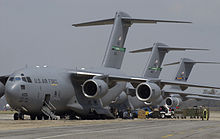 Three C-17s unload supplies to help victims of Hurricane Katrina at Keesler Air Force Base, Mississippi, in August 2005.
Three C-17s unload supplies to help victims of Hurricane Katrina at Keesler Air Force Base, Mississippi, in August 2005.
In April 1994, the C-17 program remained over budget, and did not meet weight, fuel burn, payload and range specifications. It also failed several key criteria during tests to evaluate its airworthiness.[20][21][22] There were technical problems with mission software, landing gear, and so on.[23] In May 1994, a proposal to cut the aircraft's production to as few as 32 aircraft emerged, but was rescinded.[24] A July 1994 GAO document revealed that Air Force and DoD studies from 1986 and 1991 stated the C-17 could use 6,400 more runways outside the U.S. than the C-5; it was later discovered that this study had only considered the runway dimensions, but not their strength or Load Classification Numbers (LCN). The C-5 has a lower LCN, but the USAF classify both in the same broad Load Classification Group (LCG). When considering runway dimensions and their load ratings, the C-17's worldwide runway advantage over the C-5 shrank from 6,400 to 911 airfields.[25] However, the C-17's ability to use lower quality, austere airfields was not considered.[25]
A January 1995 GAO report revealed that while the original C-17 budget was $41.8 billion for 210 aircraft, the 120 aircraft already ordered at that point had already cost $39.5 billion.[26] In March 1994, the U.S. Army had decided it no longer needed the 60,000 lb (27,000 kg) Low Altitude Parachute Extraction System (LAPES) delivery with the C-17, feeling that the 42,000 lb (19,000 kg) capability of the C-130 was sufficient; C-17 testing was limited to this lower weight. Issues with airflow prevented the C-17 from meeting its airdrop requirements. A February 1997 GAO report revealed that a C-17 with a full payload could not land on 3,000 ft (910 m) wet runways; simulations suggested 5,000 ft (1,500 m) was required.[27]
The YC-15 was transferred to AMARC to be made flightworthy again for further flight tests for the C-17 program in March 1997.[28] By the mid-1990s, most of the problems had been resolved.[29][30] The first C-17 squadron was declared operational by the U.S. Air Force in January 1995.[31] In 1996, DoD ordered another 80 aircraft for a total of 120.[32] In 1997 McDonnell Douglas merged with its former competitor, Boeing. In April 1999, Boeing proposed to cut the price of the C-17 if the Air Force bought 60 more,[33] and in August 2002, the order was increased to 180 aircraft.[34]
Continued production
Due to a dwindling order backlog, Boeing will deliver 13 C-17s in 2011. The company is transitioning to a lower production rate of 10 C-17s per year from a high of 16 per year in a bid to extend the production line through 2012 as it works to sign additional international orders. The C-17 production line was previously slated to be closed several times, but was extended due to new orders received.[35] The C-17 workforce will be reduced by approximately 1,100 through the end of 2012, mostly through the elimination of a second shift at the C-17 final assembly plant in Long Beach.
There have been 230 production C-17s delivered, including 210 to the USAF in April 2011.[36] This does not include the "T-1" prototype, which is used by the USAF for testing and development.[37] In January 2010, the USAF announced that it would end Boeing's performance-based logistics contracts to maintain the aircraft, which was a key source for projected profit growth for the company.[38]
Design
The C-17 is 174 feet (53 m) long and has a wingspan of about 170 feet (52 m). It can airlift cargo fairly close to a battle area. The size and weight of U.S. mechanized firepower and equipment have grown in recent decades from increased air mobility requirements, particularly for large or heavy non-palletized outsize cargo.
The C-17 is powered by four Pratt & Whitney F117-PW-100 turbofan engines, which are based on the commercial Pratt and Whitney PW2040 used on the Boeing 757. Each engine is fully reversible and rated at 40,400 lbf (180 kN) of gross thrust. The thrust reversers direct engine exhaust air upwards and forward, reducing the chances of foreign object damage by ingestion of runway debris, and providing enough reverse thrust to back the aircraft up on the ground while taxiing. The thrust reversers can also be used in flight at idle-reverse for added drag in maximum-rate descents.
The aircraft requires a crew of three (pilot, copilot, and loadmaster) for cargo operations. Cargo is loaded through a large aft ramp that accommodates rolling stock, such as a 69-ton (63-metric ton) M1 Abrams tank, other armored vehicles, trucks, and trailers, along with palletized cargo. The cargo compartment is 88 feet (26.82 m) long by 18 feet (5.49 m) wide by 12 feet 4 inches (3.76 m) high. The cargo floor has rollers for palletized cargo that can be flipped to provide a flat floor suitable for vehicles and other rolling stock.
Maximum payload of the C-17 is 170,900 lb (77,500 kg), and its Maximum Takeoff Weight is 585,000 lb (265,350 kg). With a payload of 160,000 lb (72,600 kg) and an initial cruise altitude of 28,000 ft (8,500 m), the C-17 has an unrefueled range of about 2,400 nautical miles (4,400 km) on the first 71 aircraft, and 2,800 nautical miles (5,200 km) on all subsequent extended-range models that include sealed center wing bay as a fuel tank. Boeing informally calls these aircraft, the C-17 ER.[39] The C-17's cruise speed is about 450 knots (833 km/h) (0.76 Mach).[40] The C-17 is designed to airdrop 102 paratroopers and their equipment. The U.S. Army BCT Ground Combat Vehicle is to be transported by the C-17.
The C-17 is designed to operate from runways as short as 3,500 ft (1,064 m) and as narrow as 90 ft (27 m). In addition, the C-17 can operate from unpaved, unimproved runways (although with greater chance of damage to the aircraft).[40] The thrust reversers can be used to back the aircraft and reverse direction on narrow taxiways using a three- (or more) point turn.[40]
Operational history
United States Air Force
The first production model was delivered to Charleston Air Force Base, South Carolina on 14 July 1993. The first squadron of C-17s, the 17th Airlift Squadron, was declared operationally ready on 17 January 1995.[41] The C-17 has broken 22 records for oversized payloads.[42] The C-17 was awarded US aviation's most prestigious award, the Collier Trophy in 1994.[43] A report to Congress detailing operations in Kosovo and Operation Allied Force noted that "One of the great success stories...was the performance of the Air Force's C-17A"[44] The C-17 flew half of the strategic airlift missions required in the operation. The aircraft allowed for deliveries via small airfields, greatly assisting the deployment; and rapid turnaround times allowed for efficient utilization.[45]
The Air Force originally programmed to buy a total of 120 C-17s, with the last one being scheduled for delivery in November 2004. The fiscal 2000 budget funded another 14 aircraft, primarily for Air Mobility Command (AMC) support of the United States Special Operations Command (USSOCOM). Basing of the original 120 C-17s was with the 437th Airlift Wing and 315th Airlift Wing at Charleston AFB, South Carolina, the 62nd Airlift Wing and 446th Airlift Wing at McChord Air Force Base, Washington (first aircraft arrived in July 1999), the Air Education and Training Command's (AETC) 97th Air Mobility Wing at Altus AFB, Oklahoma, and the Air Mobility Command-gained 172nd Airlift Wing of the Mississippi Air National Guard at Jackson-Evers International Airport/ANGB, Mississippi. Although belonging to the Air Mobility Command, the C-17s of the 172 AW are controlled by the Air National Guard (ANG).[citation needed]
Basing of the additional 13 aircraft went to the 305th Air Mobility Wing and 514th Air Mobility Wing at McGuire Air Force Base, New Jersey; the 3rd Wing and 176th Wing at Elmendorf Air Force Base, Alaska; 15th Airlift Wing and 154th Wing at Hickam Air Force Base, Hawaii; and 60th Air Mobility Wing and 349th Air Mobility Wing at Travis Air Force Base, California. An additional 60 units were ordered in May 2002. In FY 2006, eight C-17s were delivered to March Joint Air Reserve Base, California; to be controlled by the Air Force Reserve Command (AFRC). In 2007, Congress appropriated funds for 10 additional USAF C-17s, bringing the total planned fleet size to 190. Additional aircraft were subsequently assigned to Dover Air Force Base, Delaware, previously equipped with Lockheed C-5 Galaxy aircraft.[citation needed]
C-17s from the 517th Airlift Squadron dropping equipment and airborne infantry during joint training in September 2010.
The C-17 have been, and continue to be, used to deliver military goods and humanitarian aid during Operation Enduring Freedom in Afghanistan as well as Operation Iraqi Freedom in Iraq. On 26 March 2003, 15 USAF C-17s participated in the biggest combat airdrop since the United States invasion of Panama in December 1989: the night-time airdrop of 1,000 paratroopers from the 173rd Airborne Brigade occurred over Bashur, Iraq. The airdrop of paratroopers were followed by C-17s ferrying M1 Abrams, M2 Bradleys, M113s and artillery.[46] USAF C-17s have also been used to assist allies in their airlift requirements, including Canadian vehicles to Afghanistan in 2003 and the deployment of Australian forces during the Australian-led military deployment to East Timor in 2006. In late 2006, USAF C-17s flew 15 Canadian Leopard C2 tanks from Kyrgyzstan into Kandahar in support of the NATO mission in Afghanistan.
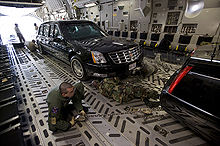 The U.S. Presidential Limousine is transported in a C-17 for long distance trips.
The U.S. Presidential Limousine is transported in a C-17 for long distance trips.
A C-17 also accompanies the President of the United States on his visits to both domestic and foreign arrangements, consultations, and meetings. The C-17 is used to transport the Presidential Limousine and security detachments.[47] There have been several occasions where a C-17 has been used to transport the President himself, temporarily gaining the Air Force One callsign while doing so.[48]
There has been debate about follow-on orders for the C-17, with the Air Force requesting line shutdown, and members of Congress attempting to reinstate production. Furthermore, in FY2007, the Air Force requested $1.6 billion to deal with what it termed "excessive combat use" on operational airframes.[49] However, in testimony before a House of Representatives subcommittee on air and land forces, General Arthur Lichte, USAF, the Commander of Air Mobility Command indicated the need to extend production to another 15 aircraft to increase the total to 205. Pending the delivery of the results of two studies in 2009, Lichte considered that the Air Force may have to keep the production line open for purchase of even more C-17s to satisfy airlift requirements.[50]
Royal Air Force
Boeing has marketed the C-17 to many European nations including Belgium, Germany, France, Italy, Spain and the United Kingdom. The Royal Air Force (RAF) has established an aim of having interoperability and some weapons and capabilities commonality with the USAF. The UK's 1998 Strategic Defence Review identified a requirement for a strategic airlifter. The Short-Term Strategic Airlift (STSA) competition commenced in September of that year, however tendering was canceled in August 1999 with some bids identified by ministers as too expensive, including the Boeing/BAe C-17 bid, and others unsuitable.[51] The project continued, with the C-17 seen as the favorite.[51] In the light of continuing delays to the Airbus A400M program, the UK Defence Secretary, Geoff Hoon, announced in May 2000 that the RAF would lease four C-17s at an annual cost of £100 million[49] from Boeing for an initial seven years with an optional two year extension. At this point the RAF would have the option to buy the aircraft or return them to Boeing. The UK committed to upgrading the C-17s inline with the USAF so that in the event of their being returned to Boeing the USAF could adopt them.
The first C-17 was delivered to the RAF at Boeing's Long Beach facility on 17 May 2001 and flown to RAF Brize Norton by a crew from No. 99 Squadron which had previously trained with USAF crews to gain competence on the type. The RAF's fourth C-17 was delivered on 24 August 2001. The RAF aircraft were some of the first to take advantage of the new center wing fuel tank found in Block 13 aircraft. In RAF service, the C-17 has not been given an official designation (for example,, C-130J referred to as Hercules C4 or C5), but is referred to simply as the C-17 or "C-17A Globemaster".
The RAF declared itself delighted with the C-17. Although the Globemaster fleet was to be a fallback for the A400M, the UK announced on 21 July 2004 that they had elected to buy their four C-17s at the end of the lease, even though the A400M appeared to be moving closer to production. They also announced there would be a follow-on order for one C-17, with possible additional purchases later.[52] While the A400M is described as a "strategic" airlifter, the C-17 gives the RAF true strategic capabilities that it would not wish to lose, for example a maximum payload of 169,500 lb (77,000 kg) compared to the A400M's 82,000 lb (37,000 kg).[49]
The Ministry of Defence (MoD) announced on 4 August 2006 that they had ordered an additional C-17 and that the four aircraft on lease would be purchased at the end of the current contract in 2008. A fifth aircraft was delivered on 22 February 2008 and reported for duty on 7 April 2008 at Brize Norton air base in Oxfordshire.[53] Due to fears that the A400M may suffer further delays, the MoD announced in 2006 that it planned to acquire three more C-17s, for a total of eight, with delivery in 2009–2010. On 26 July 2007, Defence Secretary Des Browne announced that the MoD intended to order a sixth C-17 to boost operations in Iraq and Afghanistan.[54] On 3 December 2007, the MoD announced a contract for a sixth C-17,[55] which was received on 11 June 2008.[56]
On 18 December 2009, Boeing confirmed that the RAF had ordered a seventh C-17,[57][58] which was delivered on 16 November 2010.[59] Boeing briefed the MoD in November 2010 regarding the possible acquisition of an eighth C-17, but no decision has been made. Production will be slowing down in order to extend the time before the C-17 production line has to shut down.[60]
Royal Australian Air Force
The Royal Australian Air Force (RAAF) began investigating options to acquire heavy lift transport aircraft for strategic transport in 2005.[61] In late 2005 the then Minister for Defence Robert Hill stated that the Australian Defence Force was considering such aircraft due to the limited availability of strategic airlift aircraft from partner nations and air freight companies. The C-17 was considered to be favoured over the A400M as it was a "proven aircraft" and was already in production. One major requirement from the RAAF was the ability to airlift the Army's new M1 Abrams main battle tanks; another requirement was immediate delivery. Though unstated, commonality with the USAF and the United Kingdom's RAF was also considered advantageous. The aircraft for the RAAF were ordered directly from the USAF production run, and are identical to American C-17 even in paint scheme, the only difference being the national markings. This allowed delivery to commence within nine months of commitment to the program.[62]
On 2 March 2006, the Australian Government announced the purchase of three aircraft and one option with an entry into service date of 2006.[49] In July 2006 a fixed price contract was awarded to Boeing to deliver four C-17s for US$780M (AUD$1bn).[63] Australia also signed a US$80.7M contract to join the global 'virtual fleet' C-17 sustainment program[64] and the RAAF's C-17s will receive the same upgrades as the USAF's fleet.[65]
The Royal Australian Air Force took delivery of its first C-17 in a ceremony at Boeing's plant at Long Beach, California on 28 November 2006.[66] Several days later the aircraft flew from Hickam Air Force Base, Honolulu, Hawaii to Defence Establishment Fairbairn, Canberra, arriving on 4 December 2006. The aircraft was formally accepted in a ceremony at Fairbairn shortly after arrival.[67] The second aircraft was delivered to the RAAF on 11 May 2007 and the third was delivered on 18 December 2007. The fourth Australian C-17 was delivered on 19 January 2008.[68] All the Australian C-17s are operated by No. 36 Squadron and are based at RAAF Base Amberley in Queensland.[69] The squadron is working towards reaching its full operational capability in mid-2011.[64]
On 18 April 2011, Boeing announced that the Commonwealth of Australia had signed an agreement with the U.S. government to acquire a fifth C-17, and the aircraft was delivered to the RAAF on 14 September 2011.[70] [71] On 23 September 2011 Australian Minister for Defence Materiel Jason Clare announced that the government was seeking information from the United States about the price and delivery schedule for a sixth Globemaster.[72] The US DSCA announced that Australia had made an official request for a sixth C-17A.[73]
Australia's C-17s have supported ADF operations around the world. Tasks have included supporting Air Combat Group training deployments to the United States, transporting Royal Australian Navy Sea Hawk helicopters and making fortnightly missions to the Middle East to supply Australian forces in Iraq and Afghanistan.
The C-17s have also carried humanitarian supplies to Papua New Guinea during Operation Papua New Guinea Assist in 2007, supplies and South African Puma helicopters to Burma in 2008 following Cyclone Nargis,[74] relief supplies to Samoa following the 2009 earthquake, relief supplies around Queensland following the 2010–2011 floods and Cyclone Yasi, and rescue teams and equipment to New Zealand following the February 2011 Christchurch earthquake, and delivery of equipment for mitigation of the effects caused by the 2011 Tōhoku earthquake and tsunami from Western Australia to Japan.
Royal Canadian Air Force
Canada's air force has had a long-standing need for strategic airlift for humanitarian and military operations around the world.[citation needed] The CF had followed a pattern similar to the Luftwaffe in using rented Antonovs and Ilyushins for many of their needs, including deploying the Disaster Assistance Response Team (DART) to tsunami-stricken Sri Lanka in 2005. The CF was forced to rely entirely on leased An-124 Ruslan for a deployment to Haiti in 2003.[citation needed] The service has also used a combination of leased Ruslans, Ilyushins and USAF C-17s for moving heavy equipment into Afghanistan. The Canadian Forces Future Strategic Airlifter Project was initiated in 2002 to study alternatives, including long-term leasing arrangements.[75]
On 5 July 2006, the Canadian government issued a notice that it intended to negotiate directly with Boeing for the purchase of four airlifters for the Canadian Forces Air Command.[76] On 1 February 2007, Canada awarded a contract for four C-17s with delivery beginning in August 2007.[77] Like Australia, Canada was granted airframes originally slated for the U.S. Air Force, to accelerate delivery.[78]
On 16 June 2007, the first Canadian C-17 rolled off the assembly line at Long Beach, California and into the paint hangar for painting and addition of Canadian markings including the national logo and air force roundel. The first Canadian C-17 made its initial flight on 23 July.[79] It was turned over to Canada on 8 August,[80] and participated at the Abbotsford International Airshow on 11 August prior to arriving at its new home base at 8 Wing, CFB Trenton, Ontario on 12 August.[81] Its first operational mission was delivery of disaster relief to Jamaica in the aftermath of Hurricane Dean.[82] The second C-17 arrived at 8 Wing, CFB Trenton on 18 October 2007. The last of four aircraft was delivered in April 2008.[83] The C-17 is officially designated CC-177 Globemaster III within the Canadian air service.[84] Canadian Forces Air Command was renamed to Royal Canadian Air Force (RCAF) in August 2011. The aircraft are assigned to RCAF's 429 Squadron based at CFB Trenton.
On 14 April 2010, a CF C-17 landed at Canadian Forces Station Alert, the world's most northerly airport. It was Canada's first operational unpaved runway landing with a C-17.[85] Canadian Globemasters have been deployed in support of numerous humanitarian and military missions worldwide, including Operation Hestia after the earthquake in Haiti, evacuations of foreign citizens from Libya, providing airlift as part of Operation Mobile as well as ongoing support to the Canadian Forces in Afghanistan.
NATO (Strategic Airlift Capability Program)
A number of NATO countries signed a letter of intent to purchase C-17s on 19 July 2006 at the 2006 Farnborough Airshow to participate in the joint purchase and operation of C-17s within NATO, a program called the NATO Strategic Airlift Capability.[86] A further letter of intent was announced on 12 September 2006 that included a few other countries, some of which have since withdrawn. The present members are Bulgaria, Estonia, Hungary, Lithuania, the Netherlands, Norway, Poland, Romania, Slovenia, the United States, as well as two Partnership for Peace countries Finland and Sweden.[86]
The purchase is for two C-17s, and a third which is the US contribution to the pool, which is manned in the same fashion as the NATO E-3 AWACS aircraft,[87] where the AWACS aircraft are jointly manned by crew from NATO countries. On 14 July 2009, Boeing delivered the first C-17 under NATO's Strategic Airlift Capability (SAC) program. The second and third C-17s were delivered in September and October 2009.[88][89] The aircraft are based at Pápa Air Base, Hungary. The Heavy Airlift Wing is hosted by Hungary, which acts as the flag nation.[90]
Other
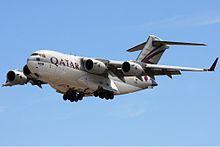 Qatar Emiri Air Force C-17 at Adelaide Airport, January 2011
Qatar Emiri Air Force C-17 at Adelaide Airport, January 2011 C-17 Globemaster III USAF video
C-17 Globemaster III USAF video
In June 2009, the Indian Air Force (IAF) selected the C-17 to fulfill its Very Heavy Lift Transport Aircraft requirement. The C-17 is to replace the Ilyushin Il-76 as the IAF's largest heavy lift transport aircraft in service.[91][92][93] In January 2010, the US Government received a request from India for 10 C-17s through the US Government's Foreign Military Sales program,[94] and was approved by US Congress in June 2010.[95] On 23 June 2010, the Indian Air Force successfully test-landed a USAF C-17 at the Gaggal Airport, India. This completed the IAF's C-17 trials.[96] An agreement to purchase 10 aircraft, with an option to purchase six more, was revealed during President Obama's visit to India in November 2010.[97] In February 2011 the IAF and Boeing agreed to terms for order of 10 C-17s[98] with an option for six more; the order was approved by the Indian Cabinet Committee on Security on 6 June 2011.[99][100][101] Deliveries are to begin two years after the contract with Boeing is finalized.[100] In June 2011, it was reported that the Indian Air Force could buy more C-17s later.[102] The Indian Air Force plans to base its C-17s at Hindon Air Force Station after deliveries in 2013-14.[103]
The Qatar Emiri Air Force operates two Boeing C-17s. Boeing delivered Qatar's first C-17 on 11 August 2009 and the second on 10 September 2009.[104]
Orders and deliveries
USAF
In 2007, 190 C-17s were on order to the USAF.[105] Congress provided funding for 15 C-17s in a FY2008 War Supplemental in June 2008.[106][107] These funds extended production from August 2009 to August 2010. On 6 February 2009, Boeing was awarded a contract for 15 additional aircraft for $2.95 billion, thus increasing C-17s on contract to the USAF to 205.[108] On 6 April 2009, US Secretary of Defense Robert Gates announced that there would be no more C-17s ordered beyond the 205 planned.[109] But a month later in May a war funding bill was put forward with funding for up to eight more aircraft.[110] On 12 June 2009, the House Armed Services Air and Land Forces Subcommittee added 17 C-17s to the total planned level.[111]
In November 2009, 205 C-17s were on contract with the USAF. A contract for eight C-17s from the supplemental war funding bill has not yet been awarded. On 18 December 2009, the US Senate passed the FY 2010 DOD budget with funding for 10 C-17s and was signed into law by the President the following day. Total USAF C-17s contracted will be 223 once contracts are awarded, extending production until 2013.
International
In February 2009, the United Arab Emirates signed an agreement to purchase four C-17 airlifters.[112] In January 2010, UAE signed a contract with Boeing for six C-17s (four C-17s in 2011, and two in 2012).[113][114]
During the summer 2008 it was reported that South Korea had allocated funds for the purchase of three or four C-17-class for use in supporting expeditionary deployments.[115] In September 2010, Kuwait requested the purchase of one C-17, spare parts and support through the U.S.'s Foreign Military Sales (FMS) program.[116]
In March 2011, Australia's Minister for Defence Stephen Smith announced that the nation had sent a Letter of Request to the United States about the possible purchase of a fifth C-17.[117] Australia ordered its fifth C-17 through the FMS program on 18 April 2011, due to an increased demand for humanitarian and disaster relief missions. Due to urgent requirements, the RAAF will receive an aircraft in August originally slated for the USAF.[118]
Commercial interest
In the mid-1990s, McDonnell Douglas began to market the C-17 to commercial civilian operators, under the name MD-17.[119] Due to its high projected fuel, maintenance and depreciation cost for a low-cycle military design in commercial service, as well as a limited market dominated by the An-124, very little interest was expressed. After McDonnell Douglas merged with Boeing, the commercial version was renamed BC-17.[120] However, the aircraft received no orders and Boeing stopped offering the BC-17 for sale.
Deliveries
1991 1992 1993 1994 1995 1996 1997 1998 1999 2000 2001 2002 2003 2004 2005 2006 2007 2008 2009 2010 2011 1 4 5 8 6 6 7 10 11 13 14 16 16 16 16 16 16 16 16 14 11 Sources: C-17 Globemaster III Pocket Guide,[121] Boeing IDS Major Deliveries[122]
Variants
A C-17 creates a visible vortex while using reverse thrust to push the aircraft backwards on a runway.
- C-17A: Initial military airlifter version.
- C-17A "ER": Unofficial name for C-17As with extended range due to the addition of the center wing tank.[39][123] This upgrade was incorporated in production beginning in 2001 with Block 13 aircraft.[123]
- C-17B: Proposed tactical airlifter version. The design includes double-slotted flaps, an additional main landing gear on center fuselage, more powerful engines and other systems for shorter landing and take-off distances.[124] Boeing offered the C-17B to the US military in 2007 for carrying the Army's Future Combat Systems (FCS) vehicles and other equipment.[125]
Operators
USAF C-17 Globemaster IIIs on a low-level training mission over the Blue Ridge Mountains in the eastern U.S.RAF, RAAF and USAF C-17s and flight crews at RAF Brize Norton in June 2007 A C-17 releases a barrage of flares. The wing-tip vortices can be seen in the flare smoke behind the aircraft.
A C-17 releases a barrage of flares. The wing-tip vortices can be seen in the flare smoke behind the aircraft.
- Royal Australian Air Force has five C-17ERs in service,[126] with a Foreign Military Sales request for a sixth.[127]
- Royal Canadian Air Force, formerly Canadian Forces Air Command, has 4 C-17ERs[83]
- Indian Air Force has signed an agreement with the US government to buy 10 C-17s with an option for 6 more.[130][131][132][133][134] India's contract with Boeing is pending.[100] The entire contract is around $ 5.8 billion.
- Heavy Airlift Wing: 3 in service,[135][136] including 1 C-17 contributed by the USAF.[137]
- Qatari Emiri Air Force has two C-17As in use.[138]
- United Arab Emirates Air Force has six C-17As on order;[114] the second was handed over in June 2011.[139][140]
- Royal Air Force has 7 C-17ERs in service.
- United States Air Force has 203 total (70 C-17, 133 C-17ER) in inventory as of November 2010.[59] 223 funded with 10 remaining on order in June 2010.[141]
-
- 3rd Wing
- 15th Airlift Wing
- 60th Air Mobility Wing
- 62nd Airlift Wing
- 97th Air Mobility Wing
- 154th Wing, ANG
- 172nd Airlift Wing, ANG
- 176th Wing, ANG
- 105th Airlift Wing, ANG
- 305th Air Mobility Wing
- 315th Airlift Wing, AFRC
-
- 349th Air Mobility Wing, AFRC
- 412th Test Wing
- 418th Flight Test Squadron
- 436th Airlift Wing
- 3rd Airlift Squadron
- 437th Airlift Wing
- 445th Airlift Wing, AFRC
- 446th Airlift Wing, AFRC
- 452nd Air Mobility Wing, AFRC
- 512th Airlift Wing, AFRC
- 514th Air Mobility Wing, AFRC
- 732nd Airlift Squadron
Accidents and incidents
- On 10 September 1998, a U.S. Air Force C-17 (AF Serial No.96-0006) suffered a landing gear failure as it landed in Vestmannaeyjar, Iceland, a 3,800-foot (1,200 m) runway, to deliver Keiko the whale. After receiving temporary repairs, it was flown to another city in Iceland for further repairs.[142][143] The total repair bill topped $1 million.
- On 10 December 2003, a U.S. Air Force C-17 (AF Serial No. 98-0057) was hit by a surface-to-air missile after take-off from Baghdad, Iraq. One engine was disabled and the aircraft returned for a safe landing.[144] The aircraft was repaired and returned to service.[145]
- On 6 August 2005, a U.S. Air Force C-17 (AF Serial No. 01-0196) ran off the runway at Bagram Air Base in Afghanistan while attempting to land, destroying the aircraft's nose and main landing gear. At the time, it was the most extensively damaged C-17 to date.[146] A Boeing recovery team spent two months getting the aircraft ready to fly back to Boeing's Long Beach production facility.[147] The five-day flight back to the United States had to be performed by a test pilot because the temporary repairs caused numerous performance limitations.[148] The repair was completed at Long Beach in October 2006 and the aircraft returned to service.
- On 30 January 2009, a U.S. Air Force C-17 (AF Serial No. 96-0002 – "Spirit of the Air Force") made a gear-up landing at Bagram Air Base.[149][150] The C-17 was ferried from Bagram AB, making several stops along the way, to Boeing's plant in Long Beach, California, for extensive repairs to return it to service. The USAF Aircraft Accident Investigation Board concluded the incident was caused by the crew's failure to lower the landing gear and having not followed the pre-landing checklist.[151]
- On 28 July 2010, a U.S. Air Force C-17 (AF Serial No. 00-0173 – "Spirit of the Aleutians") crashed on Elmendorf Air Force Base, Alaska during a training flight, killing all four aboard.[152] It was practicing for the 2010 Arctic Thunder Air Show.[153][154] The C-17 crashed near a railroad, damaged tracks and disrupted rail operations.[155] A military investigative report determined that a stall caused by pilot error led to the crash.[156] This is the first fatal operational C-17 accident and its first hull-loss incident.[155]
Specifications (C-17)
Data from USAF fact sheet,[40] Boeing,[157][158] and AerospaceWeb[159]
General characteristics
- Crew: 3: 2 pilots, 1 loadmaster
- Capacity: ** 134 troops with palletized seats or
- 102 troops with standard centerline seats or
- 36 litter and 54 ambulatory patients or
- Cargo, such as an M1 Abrams tank,[N 1][161] three Strykers, or 6 M1117 Armored Security Vehicles
- Payload: 170,900 lb (77,519 kg) of cargo distributed at max over 18 463L master pallets or a mix of palletized cargo and vehicles
- Length: 174 ft (53 m)
- Wingspan: 169.8 ft (51.75 m)
- Height: 55.1 ft (16.8 m)
- Wing area: 3,800 ft² (353 m²)
- Empty weight: 282,500 lb (128,100 kg)
- Max takeoff weight: 585,000 lb (265,350 kg)
- Powerplant: 4 × Pratt & Whitney F117-PW-100 turbofans, 40,440 lbf (180 kN) each
- Fuel capacity: 35,546 US gal (134,556 L)
Performance
- Cruise speed: Mach 0.76 (450 knots, 515 mph, 830 km/h)
- Range: 2,420 nmi[157] (2,785 mi, 4,482 km)
- Service ceiling: 45,000 ft (13,716 m)
- Max wing loading: 150 lb/ft² (750 kg/m²)
- Minimum thrust/weight: 0.277
- Takeoff run at MTOW: 7,600 ft (2,316 m)[157]
- Landing distance: 3,500 ft (1,060 m)
See also
- Related development
- Aircraft of comparable role, configuration and era
- Antonov An-124
- Ilyushin Il-76
- Lockheed C-5 Galaxy
- Lockheed C-141 Starlifter
- Related lists
- List of active Canadian military aircraft
- List of active United States military aircraft
- List of active United Kingdom military aircraft
- List of military aircraft of the United States
References
- Notes
- ^ Quote: "The operational weight limit for loading tracked vehicles across the C-17's ramp is 130,000 lbs. A waiver was granted to allow loading of an M1 Abrams tank weighing up to 135,000 lbs. This waiver was based on a structural analysis by the C-17 System Program Office (SPO) and McDonnell Douglas (now Boeing) that showed the load distribution of M1 did not detrimentally affect the ramp."[160]
- Citations
- ^ "Fa8614-06-d-2006." Department of Defense Website, 22 June 2010.
- ^ "Air Force Lets Advanced STOL Prototype Work." Wall Street Journal, 13 November 1972.
- ^ Miles, Marvin. "McDonnell, Boeing to Compete for Lockheed C-130 Successor." Los Angeles Times, 11 November 1972.
- ^ Kennedy 2004, pp. 3-20, 24.
- ^ a b c Norton 2001, pp. 12–13.
- ^ a b Norton 2001, pp. 13, 15.
- ^ "Douglas Wins $3.4B Pact to Build C-17." Los Angeles Times, 3 January 1986.
- ^ Kennedy 2004, pp. 70, 81–83.
- ^ Kennedy, Betty Raab. "Historical Realities of C-17 Program Pose Challenge for Future Acquisitions." Institute for Defense Analyses, December 1999.
- ^ Fuller, Richard L. "More load for the buck with C-17." Chicago Tribune, 9 September 1989.
- ^ Sanford, Robert. "McDonnell Plugs Away on C-17." St. Louis Post-Dispatch, 3 April 1989.
- ^ Brenner, Eliot. "Cheney cuts back on Air Force programs." Bryan Times, 26 April 1990.
- ^ "C-17's First Flight Smoother Than Debate." The New York Times, 17 September 1991.
- ^ a b Norton 2001, pp. 25–26, 28.
- ^ a b "RL30685, Military Airlift: C-17 Aircraft Program." Congressional Research Service, 5 June 2007.
- ^ "Technical Assessment Report; C-17 Wing Structural Integrity." Department of Defense, 24 August 1993. Retrieved 23 August 2011.
- ^ "C-17 Wing Fails Again; Probe Is Sought." Seattle Times, 14 September 1993. Retrieved 23 August 2011.
- ^ "Findings, Conclusions and Recommendations of the Executive Independent Review Team." US Government Executive Independent Review Team via blackvault.com, 12 December 1993. Retrieved 23 August 2011.
- ^ Evans, David. "Pentagon to Air Force: C-17 flunks." Chicago Tribune, 29 March 1993.
- ^ "Air Force Letter To Douglas Spells Out 75 Defects For C-17." Los Angeles Times, 28 May 1991.
- ^ "C-17 fails engine start test." Press-Telegram, 12 April 1994.
- ^ "Parts Orders for C-17 far too high, GAO says." Charlotte Observer, 16 March 1994.
- ^ [http://archive.gao.gov/t2pbat3/151473.pdf "The C-17 Proposed Settlement and Program Update." United States General Accounting Office, 28 April 1994.
- ^ Kreisher, Otto. "House rescinds cuts in C-17 program." San Diego Union, 25 May 1994.
- ^ a b "Comparison of C-5 and C-17 Airfield Availability." United States General Accounting Office, July 1994.
- ^ "C-17 Aircraft – Cost and Performance Issues." United States General Accounting Office, January 1995.
- ^ "C-17 Globemaster – Support of Operation Joint Endevour". United States General Accounting Office. February 1997. http://www.gao.gov/archive/1997/ns97050.pdf.
- ^ Bonny et al. 2006, p. 65.
- ^ "Air Force Secretary Says Modernization, C-17 on Track." Air Force magazine, 19 September 1995.
- ^ "Future Brightens for C-17 Program." Press-Telegram, 31 March 1995.
- ^ "Air Force fills Squadron of C-17s ." Associated Press, 18 January 1995.
- ^ Kilian, Michael. "In Record Procurement U.S. Orders 80 C17s – Plane Good Deal for 2,000 jobs in California." Chicago Tribune, 1 July 1996.
- ^ Wallace, James. "Boeing to cut price of C-17 if Air Force buys 60 more." Seattle Post, 2 April 1999.
- ^ "$9.7 Billion U.S. Deal for Boeing C-17's." The New York Times, 16 August 2002.
- ^ Vivanco, Fernando and Jerry Drelling. "Boeing C-17 Program Enters 2nd Phase of Production Rate and Work Force Reductions." Boeing Press Release, 20 January 2011.
- ^ Hoyle, Craig. "Australia to get fifth C-17 in August." Flightglobal, 19 April 2011.
- ^ Sanchez, Senior Airman Stacy. "Edwards T-1 reaches 1,000 flight milestone." 95th Air Base Wing Public Affairs, 20 March 2008.
- ^ "Why is USAF bringing maintenance in-house?" flightglobal.com, 18 May 2005. Retrieved 18 August 2011.
- ^ a b "C-17/C-17 ER Flammable Material Locations." Boeing, 1 May 2005.
- ^ a b c d "C-17 fact sheet." US Air Force , 22 October 2008.
- ^ Norton 2001, pp. 94–95.
- ^ "Boeing C-17 Globemaster III Claims 13 World Records." Boeing, 28 November 2001.
- ^ "Collier Trophy, 1990–1999 winners." National Aeronautic Association. Retrieved: 1 April 2010.
- ^ Department of Defense 2000, p. 39.
- ^ Department of Defense 2000, p. 40.
- ^ Anderson, Jon R. "1st ID task force's tanks deployed to northern Iraq." Stars and Stripes, 10 April 2003. Retrieved: 8 June 2011.
- ^ "New Mexico Airport runway damaged by President's Cargo Plane." Associated Press, 1 September 2004.
- ^ "C-17 proves its worth in Bosnian Supply effort." St Paul Pioneer, 16 February 1996.
- ^ a b c d Fulghum, D., A. Butler and D. Barrie. "Boeing's C-17 wins against EADS' A400." Aviation Week & Space Technology, 13 March 2006, p. 43.
- ^ Trimble, Stephen. "USAF reveals C-17 cracks and dispute on production future." Flightglobal.com, 4 April 2008.
- ^ a b O'Connell, Dominic. "Political clash haunts MoD deal decision." The Business (Sunday Business Group), 5 December 1999.
- ^ "RAF's Globe Master." Global Defence Review, 2003. Retrieved: 1 July 2011.
- ^ Hoyle, Craig. "UK receives fifth C-17, as RAF fleet passes 40,000 flight hours." FlightGlobal.com, 14 April 2008.}
- ^ "Browne: Purchase of extra C-17 will 'significantly boost' UK military operations." UK Ministry of Defence, 27 July 2007.
- ^ "RAF gets sixth C-17 Globemaster." UK Ministry of Defence, 4 December 2007.
- ^ "Boeing delivers 6th C-17 to Royal Air Force." Boeing, 11 June 2008.
- ^ "RAF to get 7th C-17." AirForces Monthly, 18 December 2009.}
- ^ Drelling, Jerry and Madonna Walsh. "Royal Air Force to Acquire 7th Boeing C-17 Globemaster III." Boeing, 17 December 2009.
- ^ a b Drelling, Jerry and Madonna Walsh. "Boeing delivers UK Royal Air Force's 7th C-17 Globemaster III." Boeing, 16 November 2010.
- ^ Norris, Guy. "London Unofficially Eyes Eighth Boeing C-17." AviationWeek, 18 Nov 2010.
- ^ McLaughlin 2008, pp. 40–41.
- ^ "Stock Standard". Aviation Week & Space Technology, 11 December 2006.
- ^ "Boeing wins $780 mln deal for Australia C-17s[dead link]." Reuters. 1 August 2006. Retrieved 1 July 2011.
- ^ a b McLaughlin 2008, p. 42.
- ^ McLaughlin 2008, p. 46.
- ^ "Boeing delivers Royal Australian Air Force's First C-17." Boeing, 28 November 2010. Retrieved: 13 August 2010.
- ^ "First C-17 arrives in Australia". http://www.minister.defence.gov.au/NelsonMintpl.cfm?CurrentId=6212. Retrieved 11 July 2008.[dead link]
- ^ "Air Force's C-17 fleet delivered on time, on budget." The Hon. Greg Combet MP, Parliamentary Secretary for Defence Procurement, 18 January 2008. Retrieved: 1 July 2011.
- ^ "C-17 Globemaster heavy transport." Royal Australian Air Force, 29 March 2008.
- ^ "Boeing, Australia Announce Order for 5th C-17 Globemaster III." Boeing, 30 May 2011.
- ^ "Fifth RAAF C-17 delivered." Australian Aviation, 23 September 2011. Retrieved: 15 September 2011.
- ^ Clare, Jason. "Sixth C-17A Globemaster III – Letter of Request." Department of Defence. Retrieved: 23 September 2011.
- ^ "Heavy Lifting Down Under: Australia Buys C-17s." defenseindustrydaily.com, 16 November 2011. Retrieved: 17 November 2011.
- ^ McLaughlin 2008, p. 45.
- ^ "Strategic lift capacity for Canada."[dead link] The Ploughshares Monitor, 2005.
- ^ Airlift Capability Project – Strategic ACP-S – ACAN MERX Website – Government of Canada
- ^ "O'Connor announces military plane purchase". CTV.ca, 2 February 2007.
- ^ Wastnage, J. "Canada gets USAF slots for August delivery after signing for four Boeing C-17s in 20-year C$4bn deal, settles provincial workshare squabble." Flight International, 5 February 2007. Retrieved 1 July 2011.
- ^ "Canada One C-17 makes first flight." Boeing, 25 July 2007.
- ^ "Boeing delivers Canada's First C-17." Boeing, 8 August 2007.
- ^ "First CC-177 Globemaster III Receives Patriotic and Enthusiastic Welcome." Department of National Defence.
- ^ "New military aircraft leaves on aid mission." Cnews.com, 24 August 2007.
- ^ a b "Canada takes delivery of final CC-177." Canadian Forces, 3 April 2008.
- ^ "Aircraft – CC-177 Globemaster III."[dead link] Canada's Air Force.
- ^ "Top of the world welcomes CC-177 Globemaster III." airforce.forces.gc.ca. Retrieved 18 August 2011.
- ^ a b "Strategic Airlift Capability: A key capability for the Alliance." NATO. Retrieved: 1 April 2010.
- ^ "NATP Airborne Early Warning & Control Force: E-3A Component." NATO. Retrieved: 1 April 2010.
- ^ Hoyle, Craig. "Boeing delivers first C-17 for NATO-led Heavy Airlift Wing." Flight International, 15 July 2009.
- ^ Drelling, Jerry and Eszter Ungar."3rd Boeing C-17 Joins 12-Nation Strategic Airlift Capability Initiative." Boeing, 7 October 2009.
- ^ Heavy Airlift Wing Background.
- ^ Josy, Joseph. "Russia setting, US rising in Indian air force." DNA, 17 October 2009.}
- ^ Luthra, Gulshan. "IAF Chooses C 17 Globemaster III." IndiaStrategic.in, 19 June 2009. Retrieved: 15 June 2009.
- ^ "Boeing says C-17 orders to extend line." Reuters, 16 June 2009. Retrieved: 1 July 2011.
- ^ Mathews, Neelam. "India Requests Boeing C-17s." Aviation Week, 8 January 2010.
- ^ "US Congress clears C-17 sale for India." Deccan Chronicle, 18 August 2011.
- ^ "IAF completes C-17 test-flight." Jane's Information Group, 5 July 2010.
- ^ "India speeds up defence procurement in 2010." livemint.com.
- ^ "IAF finalises order for 10 C-17 strategic airlifters." The Times Of India, 17 March 2011. Retrieved: 1 July 2011.
- ^ "India approves $4.1B Boeing C-17 order." St. Louis Business Journal, 6 June 2011.
- ^ a b c Prasad, K.V. "India to buy C-17 heavy-lift transport aircraft from U.S." The Hindu, 7 June 2011. Retrieved 7 June 2011.
- ^ "India's $4-Bn Order To Support Jobs At Boeing"[dead link]. BusinessWeek, 7 June 2011.
- ^ Economictimes.indiatimes.com "India to buy more than 16 C-17 airlifters." indiatimes.com.
- ^ Indian Air Force IAF." indiatimes.com, 10 July 2010.
- ^ Drelling, Jerry and Lorenzo Cortes. "Boeing Delivers Qatar's 2nd C-17 Globemaster III." Boeing, 10 September 2009.
- ^ "Boeing Company Funds Extension." Boeing, 9 July 2008.
- ^ "Analysis of Senate May 2008 Iraq-Afghanistan Supplemental War Funding for DOD." Center for Arms Control and Non-Proliferation, 21 May 2008.
- ^ "Bush Signs $162 Billion Supplemental War Funding Bil." Department of Defense, 30 June 2008. Retrieved: 1 July 2011.
- ^ Trimble, Stephen. "Boeing in $3bn air force contract." Flight International, 10 February 2009.
- ^ Cole, August and Yochi J. Dreazen. "Pentagon Pushes Weapon Cuts." The Wall Street Journal, 7 April 2009, p. 1.
- ^ Simon, Richard and Peter Pae. "Boeing C-17 poised to survive political turbulence." Los Angeles Times, 15 May 2009. Retrieved 31 May 2011.
- ^ Kreisher, Otto. "House panel reverses cuts in aircraft programs." Congress Daily, 12 June 2009.
- ^ Trimble, Stephen. "UAE strengthens airlift capacity with C-130J, C-17 deals." Flight International, 25 February 2009.
- ^ "Boeing, United Arab Emirates Announce Order for 6 C-17s." indiastrategic.in, 6 January 2010.
- ^ a b "Boeing, United Arab Emirates Announce Order for 6 C-17s". Boeing, 6 January 2010.
- ^ Perrett, Bradley. " C-17 In Contention For South Korean Transport." Aviation Week, 3 September 2008. Retrieved: 24 December 2008.
- ^ "Kuwait C-17 Globemaster III Aircraft and Related Support." U.S. Defense Security Cooperation Agency, 24 September 2010.
- ^ "C-17A Globemaster III Letter of Request." Australian Department of Defence, 1 March 2011.
- ^ "Boeing, Australia Announce Order for 5th C-17 Globemaster III." Boeing Press Release, 18 April 2011.
- ^ Sillia, George. "MD-17 Receives FAA Certification." Boeing, 28 August 1997.
- ^ Saling, Bob. "Boeing Is Undisputed Leader In Providing Air Cargo Capacity (Boeing proposes BC-17X)." Boeing 28 September 2000.
- ^ "C-17 Globemaster III Pocket Guide", The Boeing Company, Long Beach, CA, June 2010
- ^ "BDS Major Deliveries (current year)." Boeing, May 2011. Retrieved 17 April 2011.
- ^ a b Norton 2001, p. 93.
- ^ Trimble, Stephen. "Boeing offers C-17B as piecemeal upgrade." Flight International, 19 August 2008.
- ^ Trimble, Stephen. "Boeing offers C-17B to US Army." Flight International, 16 October 2007.
- ^ Anderson, Cindy and James Baker. "Boeing Delivers Royal Australian Air Force's 5th C-17 Globemaster III" 14 September 2011. Retrieved 16 September 2011.
- ^ "Minister for Defence – Sixth C-17A Globemaster III – Letter of Request". Department of Defence (Australia). 23 September 2011. http://www.minister.defence.gov.au/2011/09/23/minister-for-defence-sixth-c-17a-globemaster-iii-%E2%80%93-letter-of-request/. Retrieved 24 September 2011.
- ^ "Master plan for C-17s." Air Force News, Volume 48, No. 4, 23 March 2006.
- ^ "Canada's New Government Re-Establishes Squadron to Support C-17 Aircraft." Canadian Department of National Defence, 18 July 2007.
- ^ "Boeing says more India C-17 orders possible". Reuters
- ^ "Corporate America hails India's decision to buy 10 Boeing C17s." MSN, 7 June 2011.
- ^ "Breaking News From The Department of Homeland Security: Boeing To Build 10 C-17s for India." Agence France-Presse, 15 June 2011.
- ^ "Boeing to build C-17 Airlifters for India." Agence France-Presse. 16 June 2011.
- ^ "Indian Air Force." Boeing.
- ^ "Multinational Alliance's 1st Boeing C-17 Joins Heavy Airlift Wing in Hungary." Boeing, 27 July 2009.
- ^ "3rd Boeing C-17 Joins 12-Nation Strategic Airlift Capability Initiative." Boeing, 7 October 2009.
- ^ Trimble, Stephen. "Boeing delivers second C-17 for multinational operations." Flight International, 18 September 2009.
- ^ "Boeing Delivers Qatar's 2nd C-17 Globemaster III." Boeing, 10 September 2009.
- ^ "UAE receives first C-17 transport." flightglobal.com, 11 May 2011.
- ^ "Boeing delivers UAE Air Force and Air Defence's 2nd C-17." AMEinfo, 14 June 2011.
- ^ "USAF Lets C-17 Contract." Air Force Magazine Daily Report, 24 June 2010.
- ^ C-17A S/N 96-0006
- ^ "C-17 Accident During Whale Lift Due To Design Flaw."
- ^ "Information on 98-0057 incident." Aviation-Safety.net.
- ^ "C-17, tail 98-0057 image from 2004." airliners.net.
- ^ "Bagram Runway Reopens After C-17 Incident." DefendAmerica News Article.
- ^ "The Big Fix." Boeing Frontiers Online, February 2006.
- ^ "Skypark Pilots Honored." skypark.org, 19 August 2011.
- ^ "Bagram Air Base runway recovery". US Air Force, 4 February 2009.
- ^ "Bagram C-17 Accident Investigation Board complete". U.S. Air Force, 7 May 2009.
- ^ "Aircraft Accident Investigation Board Report." USAF Aircraft Accident Investigation Board, 5 May 2009. Retrieved: 3 September 2010.
- ^ "Breaking: C-17 Crashes At Air Force Base In Alaska". q13fox.com, 28 July 2010.
- ^ "Military plane that crashed was practicing for Alaska air show." CNN, 29 July 2010. Retrieved: July 2011.
- ^ "Four Dead in Alaska Air Force Base Crash." cbsnews.com, 29 July 2010.
- ^ a b "Arctic Thunder to continue after 4 died." adn.com, 30 July 2010.
- ^ "Pilot error cause of Alaska cargo plane crash, report concludes." CNN, 11 December 2010. Retrieved: 1 July 2011.[dead link]
- ^ a b c "Boeing C-17 Globemaster III Overview." Boeing, May 2008.
- ^ C-17 Globemaster III, Technical Specifications. Boeing
- ^ "C-17 Globemaster III page." Aerospaceweb.org.
- ^ "Welcome to Deployability Engineering!" combatreform.org.
- ^ Tuttle, William G. T. Jr. "Mobility." Washington, D.C.: Defense Science Board Task Force, Office of the Under Secretary of Defense For Acquisition, Technology, and Logistics, September 2005.
- Bibliography
- Bonny, Danny, Barry Fryer and Martyn Swann. AMARC MASDC III, The Aerospace Maintenance and Regeneration Center, Davis-Monthan AFB, AZ, 1997–2005. Surrey, UK: British Aviation Research Group, 2006. ISBN 978-0-906339-07-7.
- Department of Defense. Kosovo/Operation Allied Force After-Action Report, 31 January 2000.
- Gertler, Jeremiah. "Air Force C-17 Aircraft Procurement: Background and Issues for Congress." Congressional Research Service, 22 December 2009.
- Kennedy, Betty R. Globemaster III: Acquiring the C-17. McConnell AFB, Kansas: Air Mobility Command Office of History, 2004.
- McLaughlin, Andrew. "Big Mover." Canberra: Australian Aviation (Phantom Media), September 2008.
- Norton, Bill. Boeing C-17 Globemaster III (Warbird Tech, Vol. 30). North Branch, Minnesota: Specialty Press, 2001. ISBN 1-58007-040-X.
External links
 External images
External imagesC-17 Globemaster III Cutaway 
Boeing C-17 Globemaster II Cutaway from Flightglobal.com - C-17 page on Boeing.com
- C-17 USAF fact sheet
- C-17 History page on Boeing.com
- C-17 page on GlobalSecurity.org
- C-17 detailed photographs on b-domke.de
- C-17 interior used for passenger transport
- C-17 political support site
- C-17 photos on Airliners.net
- Demo C-17s in India
McDonnell and McDonnell Douglas military aircraft and spacecraft Fighters USAAF/US Air ForceUS Navy/USMCExportLicensedAttack US Navy/USMCTrainers US NavyTransports US Air ForceUS NavyLicensedHelicopters US Army/US Air ForceUS NavyXHJH · XHCH · XHRH
ExportDrones (UAVs) US NavyKDH
Experimental US Army/US Air ForceXV-1 · X-36 · F-15 STOL/MTD · Bird of Prey
Spacecraft NASAUS Air ForceBoeing military aircraft Fighters/attack aircraft: Bombers Piston-engined transports Jet transports Tanker-transports Trainers Patrol and surveillance Reconnaissance Drones/UAVs Experimental/prototypes United States tri-service transport designations post-1962 C-1 · C-2 · C-3 · C-4 · C-5 · C-6 · C-7 · C-8 · C-9 · KC-10 · C-11 · C-12 · (C-13 not assigned) • C-14 · C-15 · (C-16 not assigned) • C-17 · C-18 · C-19 · C-20A/B/C/D · C-20F/G/H · C-21 · C-22 · C-23 · C-24 · C-25 · C-26 · C-27 / C-27J · C-28 · C-29 · (C-30 not assigned) • C-31 · C-32 · C-33 · C-35 · (C-36 not assigned) • C-37 · C-38 · C-40 · C-41 · (C-42 to C-44 not assigned) • KC-45 • KC-46
Canadian Forces unified aircraft designations post-1968 100-125 126–150 151- Lists relating to aviation General Aircraft (manufacturers) · Aircraft engines (manufacturers) · Airlines (defunct) · Airports · Civil authorities · Museums · Registration prefixes · Rotorcraft (manufacturers) · TimelineMilitary Accidents/incidents Records Categories:- Boeing aircraft
- McDonnell Douglas aircraft
- United States military transport aircraft 1990–1999
- Quadjets
Wikimedia Foundation. 2010.


